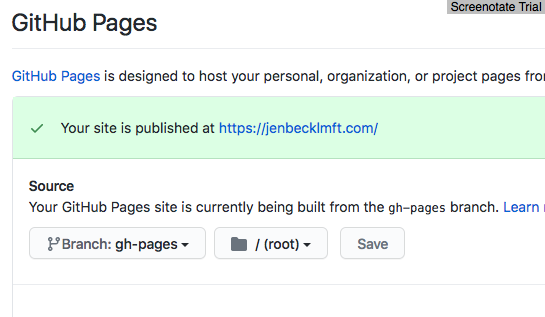My sister just went out on her own as a therapist in Eugene, Oregon and so I had to get a website set up for her - JenBeckLMFT.com. I was pleased to find out about Corvid, a static-site generator written in Python that was really stripped down and perfect for being able to turn a few markdown files into a basic ‘brochure’ website. Getting it to publish to GitHub Pages smoothly was a bit of a hurdle so hopefully this documentation will help someone else with getting a site set up with a bit more ease.
Corvid publishes its HTML files to an output folder by default and allows you to specify a folder at build time by running corvid -o <foldername> (replace <foldername> with the actual folder name you want to use). Incidentally, GitHub Pages will only deploy from a folder named docs so that’s what it would’ve had to have been (alternatively, it’ll also work with files in the default directory or in the base of a gh-pages branch). I was being super lazy and didn’t want to have to look up/ remember that command option each time I infrequently published so I thought it might be a time to learn GitHub Actions to automate renaming the default output folder to docs.
It took a while to find a good resource but peaceiris has an excellent write-up on writing GitHub Actions in many languages for deploying static site generated websites at dev.to. So no longer was I simply renaming a folder but their action automates the deployment process entirely! I no longer have to build the files locally, change the name of the deployed folder and then push that to GitHub. Now I just make whatever changes are needed to the source files locally and push my main branch to GitHub. The whole process starts with the following GitHub Action/ YAML code and deploying it is done by saving it to a .yml file in your default Git branch two folders deep in a folder structure like .github/workflows/NameOfYourChoice.yml (the first folder is really .github and I think you can name the final filename whatever you’d like - mine is publishingCorvid.yml)
name: github pages
on:
push:
branches:
- main
jobs:
deploy:
runs-on: ubuntu-18.04
steps:
- uses: actions/checkout@v2
- name: Setup Python
uses: actions/setup-python@v1
with:
python-version: "3.9"
architecture: "x64"
- name: Cache dependencies
uses: actions/cache@v1
with:
path: ~/.cache/pip
key: ${{ runner.os }}-pip-${{ hashFiles('**/requirements.txt') }}
restore-keys: |
${{ runner.os }}-pip-
- name: Install dependencies
run: |
python3 -m pip install --upgrade pip
python3 -m pip install -r ./requirements.txt
corvid
- name: Deploy
uses: peaceiris/actions-gh-pages@v3
with:
github_token: ${{ secrets.GITHUB_TOKEN }}
publish_dir: ./output
From there, the GitHub action kicks in whenever I push my local changes to GitHub, I think spinning up a Docker container to deal with the deploy (note I did change my default branch to main so make sure the 6th line matches your default branch name). Then you need to make sure you have a requirements.txt file in your project’s folder (from the command line run pip freeze > requirements.txt to create it automatically). After the default python commands to upgrade pip and install all the required packages from requirements.txt you need to run the actual command for building your static site generator. In this case it is corvid. The last part is the magic of peaceiris’s separate gh-pages GitHub Action because it takes whatever is in the folder in the last line (publish_dir) and pushes it to a separate gh-pages branch within your Git(/Hub) repository (you don’t have to set up the gh-pages branch in advance). Incidentally, I also updated the python version to 3.9 expecting it to break but it worked fine and I’m thinking is more future proof.
Remember earlier that I said GitHub Pages will only work with files located in your branch’s home directory or a docs folder or in the base of a gh-pages branch. Well that last option is now set for us. We just have to go into our repository’s page and specify the gh-pages branch as the source. Go to your project’s repository on GitHub and click on Settings.

Scroll most of the way down the page and under GitHub Pages and then Source you want to select Branch: gh-pages (You can leave / (root) selected).

If you do select a custom domain here, GitHub will quietly add a textfile named CNAME to your gh-pages branch with the domain name that you entered on the first line of the file. Unfortunately, Corvid will wipe that file out on your next deploy and disable your custom domain so you want to copy that CNAME file to your local input folder so that it’s deployed along with every future deploy. Good luck and if you have any difficulty feel free to reach out.